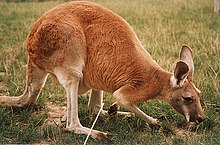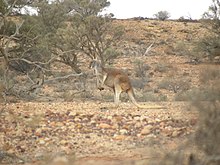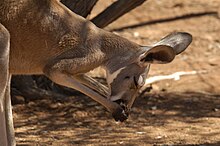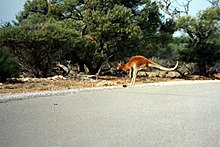Red kangaroo: Difference between revisions
Pinethicket (talk | contribs) m Reverted edits by 12.139.86.139 (talk) to last version by EmausBot |
|||
| Line 22: | Line 22: | ||
The '''red kangaroo''' (''Macropus rufus'') is the largest of all [[kangaroo]]s, the largest [[mammal]] native to [[Australia]], and the [[Largest mammals#Marsupials (Marsupialia)|largest]] surviving [[marsupial]]. It is found across mainland [[Australia]], avoiding only the more fertile areas in the south, the east coast, and the northern rainforests. |
The '''red kangaroo''' (''Macropus rufus'') is the largest of all [[kangaroo]]s, the largest [[mammal]] native to [[Australia]], and the [[Largest mammals#Marsupials (Marsupialia)|largest]] surviving [[marsupial]]. It is found across mainland [[Australia]], avoiding only the more fertile areas in the south, the east coast, and the northern rainforests. |
||
==Description== |
|||
The red kangaroo is the largest marsupial. Males are orange red in color, while the smaller females blue gray. Like gray kangaroos, the red kangaroo bounds along on its hind legs. It eats grass shoots, herbs, and leaves. |
|||
[[File:Female Red Kangaroo (Macropus rufus).jpg|thumb|left|Female red kangaroo]] |
|||
This species is a very large kangaroo with long, pointed ears and a squared-off muzzle. Males have short, red-brown fur, fading to pale buff below and on the limbs. Females are smaller than males and are blue-grey with a brown tinge, pale grey below, although arid zone females are coloured more like males. It has two forelimbs with small claws, two muscular hind-limbs, which are used for jumping, and a strong tail which is often used to create a tripod when standing upright. |
|||
The red kangaroo's legs work much like a rubber band. The males can leap over {{convert|9|m}} in one leap.<ref> |
|||
{{cite web|url=http://www.zoo.org.au/Healesville/About/Our_Animals/Red_Kangaroo|title=Red Kangaroo – Zoos Victoria|publisher=www.zoo.org.au|accessdate=2009-04-16|archiveurl=http://web.archive.org/web/20080714103312/http://www.zoo.org.au/Healesville/About/Our_Animals/Red_Kangaroo|archivedate=2008-07-14}}</ref> |
|||
Males grow up to a body length of {{convert|3|m}} long and weigh up to {{convert|135|kg}}. Females reach a body length of up to {{convert|1.1|m|ft}} long and weigh up to {{convert|35|kg}}. Tails can be from {{convert|0.9|to(-)|1|m|ft}} long. The average red kangaroo stands approximately {{convert|1.5|m|ft}} tall.<ref>Menkhorst, P & Knight, F 2001, ''A Field Guide to the Mammals of Australia,'' Oxford University Press, Melbourne ISBN 0-19-555037-4.</ref> Accounts of sizes greater than this are not uncommon, with some large males reportedly reaching approximately {{convert|2|m}}. |
|||
The red kangaroo maintains its internal temperature at a point of homeostasis about {{convert|36|C}} using a variety of physical, physiological, and behavioural adaptations. These include having an insulating layer of fur, being less active and staying in the shade when temperatures are high, panting, sweating, and licking its forelimbs. |
|||
The red kangaroo's range of vision is approximately 300°, due to the position of its eyes.{{citation needed|date=October 2009}} |
|||
==Ecology== |
==Ecology== |
||
Revision as of 20:14, 14 April 2012
| Red kangaroo[1] | |
|---|---|

| |
| Scientific classification | |
| Kingdom: | |
| Phylum: | |
| Class: | |
| Infraclass: | |
| Order: | |
| Family: | |
| Genus: | |
| Species: | M. rufus
|
| Binomial name | |
| Macropus rufus Desmarest, 1822
| |

| |
The red kangaroo (Macropus rufus) is the largest of all kangaroos, the largest mammal native to Australia, and the largest surviving marsupial. It is found across mainland Australia, avoiding only the more fertile areas in the south, the east coast, and the northern rainforests.
Description

This species is a very large kangaroo with long, pointed ears and a squared-off muzzle. Males have short, red-brown fur, fading to pale buff below and on the limbs. Females are smaller than males and are blue-grey with a brown tinge, pale grey below, although arid zone females are coloured more like males. It has two forelimbs with small claws, two muscular hind-limbs, which are used for jumping, and a strong tail which is often used to create a tripod when standing upright.
The red kangaroo's legs work much like a rubber band. The males can leap over 9 metres (30 ft) in one leap.[3]
Males grow up to a body length of 3 metres (9.8 ft) long and weigh up to 135 kilograms (298 lb). Females reach a body length of up to 1.1 metres (3.6 ft) long and weigh up to 35 kilograms (77 lb). Tails can be from 0.9 to 1 metre (3.0–3.3 ft) long. The average red kangaroo stands approximately 1.5 metres (4.9 ft) tall.[4] Accounts of sizes greater than this are not uncommon, with some large males reportedly reaching approximately 2 metres (6 ft 7 in).
The red kangaroo maintains its internal temperature at a point of homeostasis about 36 °C (97 °F) using a variety of physical, physiological, and behavioural adaptations. These include having an insulating layer of fur, being less active and staying in the shade when temperatures are high, panting, sweating, and licking its forelimbs.
The red kangaroo's range of vision is approximately 300°, due to the position of its eyes.[citation needed]
Ecology


The red kangaroo ranges throughout western and central Australia. Its range encompasses scrubland, grassland, and desert habitats. It prefers open grassland and prefers areas with scattered trees for shade.[5] Red kangaroos have adapted to their arid environment by selecting relatively high quality forage and having good conservation of body water. Compared to those of the eastern wallaroo, the kangaroo’s kidneys have a greater concentrating ability and their urine is found to be consistently more concentrated, particularly in the summer.[6] Red kangaroo prefer to eat green plants, particularly newly sprouted grasses and forbs, which they can select even when the vegetation is seemingly dry and brown.[7] One study of kangaroos in central Australia found that green grass makes up 75–95% of their diet and consists mostly of Eragrostis setifolia at 54%, which can remain green even during dry times.[8] Another study in western New South Wales found this grass species along with the bottlebrush Enneapogon avanaceus made as much as 21–69% of the red kangaroo’s diet and it seems like they were deliberately selecting the two species.[9] In dry conditions, kangaroos congregate on open plains and along watercourses were they can find green grass growing.[7] While they prefer grasses and forbs, red kangaroos will also eat certain species of chenopods, like Bassia diacantha and Maireana pyramidata, and will even browse shrubs when its favoured foods are scarce.[7] Some perennial chenopods, such as round-leaf chenopod Kochia are avoided even when abundant.[10]
At times, red kangaroos congregate in large numbers; in areas with much forage, these groups can number as much as 1,500 individuals. Red kangaroos are mostly crepuscular and nocturnal, resting in the shade during the day.[11] However, they sometimes move about during the day. Red kangaroos usually do not hang around rocky outcrops or caves and instead take shelter under small saltbushes or mulga bushes when trying to avoid extreme temperatures of midday.[7] Most of their active period is spent in grazing. Like most kangaroo species, they are mostly sedentary, staying within a relatively well-defined home range. However, great environmental changes can cause them to travel great distances.[7] In New South Wales, kangaroos have been recorded having weekly home ranges of 258–560 ha, with large males occupying the largest areas.[12] When forage is poor and rainfall patchy, kangaroos will travel 25–30 km to more favourable feeding grounds.[9] In another study of kangaroos in central Australia found that two-thirds of them stayed within 1 km of persistent forage during dry times but moved up to 28 km to feed on the newlym growth ephemeral forbs and grasses after great rainfalls.[13] The red kangaroo is too big to be subject to significant non-human predation. They can use their robust legs and clawed feet to defend themselves from attackers with kicks and blows. However, dingoes and eagles will kill and eat joeys. Joeys are thus protected in their mother's pouch. The red kangaroo did have major predators that are now extinct. The thylacine, considered by palaeontologists to have once been a major natural predator of the kangaroo, is now extinct. Other extinct predators included the marsupial lion, megalania, and the wonambi. Kangaroos are adept swimmers, and often flee into waterways if threatened by a predator. If pursued into the water, a kangaroo may use its forepaws to hold the predator underwater so as to drown it.[14]
Behaviour

Red kangaroos will associate in small groups of 2–4 members. The most common groups are females with young-at-foot.[7] In areas with higher densities of kangaroos, females coalesce in larger groups usually with one male.[15] Membership of these groups is very flexible, and males (boomers) are not territorial, fighting only over females (flyers) that come into heat. Males develop proportionately much larger shoulders and arms than females.[16] Most agonistic interactions occur between young males, which engage in ritualised fighting known as boxing. They usually stand up on their hind limbs and attempt to push their opponent off balance by jabbing him or locking forearms. If the fight escalates, they will begin to kick each other. Using their tail to support their weight, they deliver kicks with their powerful hind legs. Compared to other kangaroo species, fights between males kangaroos tend to involve more wrestling, using their powerful forearms and pectoral girdles to engage in direct physical contests of strength.[17] Fights establish dominance relationships among males, and determine who gets access to estrous females.[7] Alpha males make agonistic behaviours and more sexual behaviours until they are overthrown. Displaced males live alone and avoid close contact with others.[7]

Reproduction
The red kangaroo breeds all year round. The females have the unusual ability to delay birth of their baby until their previous Joey has left the pouch. This is called embryonic diapause. Copulation may last 25 minutes.[17] The red kangaroo has the typical reproductive system of a kangaroo. The neonate emerges after only 33 days. Usually only one young is born at a time. It is blind, hairless, and only a few centimetres long. Its hind legs are mere stumps; it instead uses its more developed forelegs to climb its way through the thick fur on its mother's abdomen into the pouch, which takes about three to five minutes. Once in the pouch, it fastens onto one of the two teats and starts to feed. Almost immediately, the mother's sexual cycle starts again. Another egg descends into the uterus and she becomes sexually receptive. Then, if she mates and a second egg is fertilised, its development is temporarily halted. Meanwhile, the neonate in the pouch grows rapidly. After approximately 190 days, the baby (called a joey) is sufficiently large and developed to make its full emergence out of the pouch, after sticking its head out for a few weeks until it eventually feels safe enough to fully emerge. From then on, it spends increasing time in the outside world and eventually, after around 235 days, it leaves the pouch for the last time.[18] The young Joey will permanently leave the pouch at around 235 days old, but will continue to suckle until it reaches 12 months of age. A doe may reproduce as early as 18 months of age and as late as five years during drought, but normally she is two and a half before she begins to breed.[19]
The female kangaroo is usually permanently pregnant, except on the day she gives birth; however, she has the ability to freeze the development of an embryo until the previous joey is able to leave the pouch. This is known as diapause, and will occur in times of drought and in areas with poor food sources. The composition of the milk produced by the mother varies according to the needs of the joey. In addition, red kangaroo mothers may have up to three generations of offspring simultaneously; a young-at-foot suckling from an elongated teat, a young in the pouch attached to a second teat and a blastula in arrested development in the uterus.[17]
Relationship with humans

The red kangaroo is still an abundant species and is protected in many national parks. It has even benefited from the spread of agriculture and creation of man-made waterholes. However competition with livestock and rabbits poses a threat. It is also often shot by farmers as a pest.
Kangaroos dazzled by headlights or startled by engine noise often leap in front of vehicles, severely damaging or destroying smaller or unprotected vehicles. The risk of harm to vehicle occupants is greatly increased if the windscreen is the point of impact. As a result, "kangaroo crossing" signs are commonplace in Australia.
Commercial use
The kangaroo is so numerous that there is regulated harvest of its hide and meat. Hunting permits and commercial harvesting are controlled under nationally approved management plans, which aim to maintain red kangaroo populations and manage them as a renewable resource. Harvesting of kangaroos is controversial, particularly due to the animal's popularity.[19]
In the year 2000, 1,173,242 animals were killed.[20] In 2009 the government put a limit of 1,611,216 for the number of red kangaroos available for commercial use. The kangaroo industry is worth about A$270 million each year, and employs over 4000 people.[21] The kangaroos provide meat for both humans and pet food. Kangaroo meat is very lean with only about 2% fat. Their skins are used for leather.
See also
References
- ^ Groves, C. P. (2005). Wilson, D. E.; Reeder, D. M. (eds.). Mammal Species of the World: A Taxonomic and Geographic Reference (3rd ed.). Baltimore: Johns Hopkins University Press. p. 66. ISBN 0-801-88221-4. OCLC 62265494.
- ^ Template:IUCN2008 Database entry includes justification for why this species is of least concern
- ^ "Red Kangaroo – Zoos Victoria". www.zoo.org.au. Archived from the original on 14 July 2008. Retrieved 16 April 2009.
- ^ Menkhorst, P & Knight, F 2001, A Field Guide to the Mammals of Australia, Oxford University Press, Melbourne ISBN 0-19-555037-4.
- ^ Dawson, T.J. (1995) Kangaroos: Biology of the Largest Marsupials. UNSW Press, Sydney ISBN 0-8014-8262-3.
- ^ T. J. Dawson and M.J.S. Denny (1969). "A bioclimatological comparison of the summer day microenvironments of two species of arid zone kangaroo". Ecology. 50 (2): 328–332. doi:10.2307/1934861.
- ^ a b c d e f g h C. Hugh Tyndale-Biscoe (2005). Life of marsupials. Csiro Publishing. pp. 321–324. ISBN 978-0-643-06257-3. Retrieved 6 December 2011.
- ^ Newsome, A.E. (1975). "An ecological comparison of the two arid-zone kangaroos of Australia, and their anomalous prosperity since the introduction of ruminant stock to their environment". Quarterly review of Biology. 50 (4): 389–424. doi:10.1086/408742. PMID 1221459.
- ^ a b Graeme Caughley; Neil Shepherd; Jeff Short (19 November 2009). Kangaroos: Their Ecology and Management in the Sheep Rangelands of Australia. Cambridge University Press. ISBN 978-0-521-12340-2. Retrieved 6 December 2011.
- ^ BA Ellis, EM Russell, TJ Dawson, CIF Harrop (1977). "Seasonal changes in diet preferences of free-ranging red kangaroos, euros and sheep in western New South Wales". Australian Wildlife Research. 4 (2): 127–144. doi:10.1071/WR9770127.
{{cite journal}}: CS1 maint: multiple names: authors list (link) - ^ Leonard Cronin (1 January 2008). Cronin's Key Guide to Australian Mammals. Allen & Unwin. ISBN 978-1-74175-110-9. Retrieved 6 December 2011.
- ^ Croft, D. B. (1991). "Home range of the red kangaroo Macropus rufus," Journal of Arid Environments 20:83–98.
- ^ Newsome, A. E. (1965). "The distribution of red kangaroos Megaleia rufa (Desmarest), about sources of persistent food and water in central Australia" (PDF). Australian Journal of Zoology. 13 (2): 289–300. doi:10.1071/ZO9650289.
- ^ Canadian Museum of Nature – Kangaroo. Retrieved 6 January 2007.
- ^ Johnson, C. N. (1983). "Variations in Group Size and Composition in Red and Western Grey Kangaroos, Macropus rufus (Desmarest ) and M. fulignosus (Desmarest)". Australian Wildlife Research. 10: 25–31. doi:10.1071/WR9830025.
- ^ P. Jarman (1983). "Mating system and sexual dimorphism in large, terrestrial, mammalian herbivores". Biological Reviews. 58 (4): 485–520. doi:10.1111/j.1469-185X.1983.tb00398.x.
- ^ a b c Dale R. McCullough and Yvette McCullough, (2000) Kangaroos in Outback Australia, Columbia University Press. ISBN 0-231-11916-X.
- ^ Evolution of Biodiversity, BCB705 Biodiversity, University of the Western Cape
- ^ a b Serventy, Vincent (1985). Wildlife of Australia. South Melbourne: Sun Books. pp. 38–39. ISBN 0-7251-0480-5.
{{cite book}}: Cite has empty unknown parameter:|coauthors=(help) - ^ "National commercial Kangaroo harvest quotas". www.environment.gov.au. Retrieved 16 April 2009.
- ^ "Kangaroo Industry Assocn of Australia – Background Info". www.kangaroo-industry.asn.au. Retrieved 16 April 2009.

